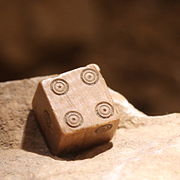Dice

Dice(sg.:dieordice)[1]are small, throwable objects with marked sides that can rest in multiple positions. They are used for generatingrandom values,commonly as part oftabletop games,includingdice games,board games,role-playing games,andgames of chance.
A traditional die is acubewith each of its six faces marked with a different number of dots (pips) from one to six. When thrown or rolled, the die comes to rest showing a randomintegerfrom one to six on its upper surface, with each value being equally likely. Dice may also havepolyhedralor irregular shapes, may have faces marked with numerals or symbols instead of pips and may have theirnumberscarved out from thematerialof the dice instead of marked on it. Loaded dice are specifically designed or modified to favor some results over others forcheatingor entertainment.
History[edit]
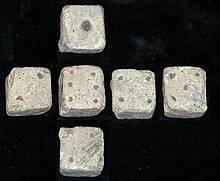
Dice have been used since before recorded history, and it is uncertain where they originated. It is theorized that dice developed from the practice of fortune-telling with thetalusof hoofed animals, colloquially known asknucklebones.[2]TheEgyptiangame ofsenet(played before 3000BCEand up to the 2nd century CE) was played with flat two-sided throwsticks which indicated the number of squares a player could move, and thus functioned as a form of dice.[3]Perhaps the oldest known dice were excavated as part of abackgammon-like game set at theBurnt City,an archeological site in south-easternIran,estimated to be from between 2800 and 2500 BCE.[4][5]Bone dice fromSkara Brae,Scotland have been dated to 3100–2400 BCE.[6]Excavations from graves atMohenjo-daro,anIndus Valley civilizationsettlement, unearthedterracottadice dating to 2500–1900 BCE,[7]including at least one die whose opposite sides all add up to seven, as in modern dice.[8]
Games involving dice are mentioned in theancient IndianRigveda,Atharvaveda,MahabharataandBuddhist games list.[9]There are severalbiblicalreferences to "casting lots" (Hebrew:יפילו גורלyappîlū ḡōrāl), as inPsalm22, indicating that dicing (or a related activity) was commonplace when the psalm was composed. Knucklebones was agame of skillplayed inancient Greece;a derivative form had the four sides of bones receive different values like modern dice.[10]

Although gambling was illegal, manyRomanswere passionate gamblers who enjoyed dicing, which was known asaleam ludere( "to play at dice" ). There were two sizes of Roman dice.Taliwere large dice inscribed with one, three, four, and six on four sides.Tesseraewere smaller dice with sides numbered from one to six.[11]Twenty-sided dice date back to the 2nd century CE[12]and fromPtolemaic Egyptas early as the 2nd century BCE.[13]
Dominoesandplaying cardsoriginated in China as developments from dice.[14]The transition from dice to playing cards occurred in China around theTang dynasty(618–907 CE), and coincides with the technological transition from rolls of manuscripts toblock printedbooks.[15]In Japan, dice were used to play a popular game calledsugoroku.There are two types of sugoroku.Ban-sugorokuis similar tobackgammonand dates to theHeian period(794–1185 CE), whilee-sugorokuis aracing game.[16]
-
Knucklebonesdie, made ofsoapstone
-
Roman die
-
A collection of historical dice from various regions of Asia
-
Chinese dice from Late Yuan Dynasty to early Qing Dynasty inJiangyinMuseum, China.
Use[edit]
Dice are thrown onto a surface either from the hand or from a container designed for this (such as a cup, tray, ortower). The face (or corner, in cases such as tetrahedral dice, or edge, for odd-numberedlong dice) of the die that is uppermost when it comes to rest provides the value of the throw.
The result of a die roll is determined by the way it is thrown, according to the laws ofclassical mechanics(althoughluckis often credited for the results of a roll). A die roll is maderandomby uncertainty in minor factors such as tiny movements in the thrower's hand; they are thus a crude form ofhardware random number generator.
One typical contemporarydice gameiscraps,where two dice are thrown simultaneously and wagers are made on the total value of the two dice. Dice are frequently used to introduce randomness intoboard games,where they are often used to decide the distance through which a piece will move along the board (as inbackgammonandMonopoly).
Construction[edit]
Arrangement[edit]
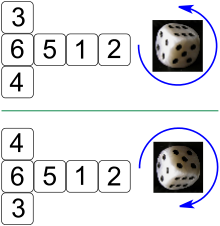
Common dice are smallcubes,most often 1.6 cm (0.63 in) across, whose faces are numbered from one to six, usually by patterns of round dots calledpips.(While the use ofArabic numeralsis occasionally seen, such dice are less common.)
Opposite sides of a modern die traditionally add up to seven, requiring the 1, 2, and 3 faces to share avertex.[17]The faces of a die may be placedclockwise or counterclockwiseabout this vertex. If the 1, 2, and 3 faces run counterclockwise, the die is called "right-handed". If those faces run clockwise, the die is called "left-handed". Western dice are normally right-handed, and Chinese dice are normally left-handed.[18]
The pips on standard six-sided dice are arranged in specific patterns as shown. Asian style dice bear similar patterns to Western ones, but the pips are closer to the center of the face; in addition, the pips are differently sized on Asian style dice, and the pips are colored red on the 1 and 4 sides. Red fours may be of Indian origin.[18][19]
-
Typical facets showing the more compact pip arrangement of an Asian-style die (top) vs. a Western-style die (bottom)
Manufacturing[edit]
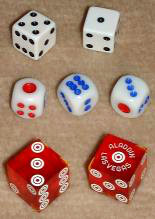
Non-precision dice are manufactured via the plasticinjection moldingprocess, often made ofpolymethyl methacrylate (PMMA).The pips or numbers on the die are a part of the mold. Different pigments can be added to the dice to make them opaque or transparent, or multiple pigments may be added to make the dice speckled or marbled.[20]
The coloring for numbering is achieved by submerging the die entirely in paint, which is allowed to dry. The die is then polished via atumble finishingprocess similar torock polishing.Theabrasive agentscrapes off all of the paint except for the indents of the numbering. A finer abrasive is then used to polish the die. This process also produces the smoother, rounded edges on the dice.
Precision casino dice may have a polished or sand finish, making them transparent or translucent respectively. Casino dice have their pips drilled, then filled flush with a paint of the samedensityas the material used for the dice, such that the center of gravity of the dice is as close to the geometric center as possible. This mitigates concerns that the pips will cause a small bias.[21]All such dice are stamped with aserial numberto prevent potential cheaters from substituting a die. Precision backgammon dice are made the same way; they tend to be slightly smaller and have rounded corners and edges, to allow better movement inside the dice cup and stop forceful rolls from damaging the playing surface.
Etymology and terms[edit]
The word die comes fromOld Frenchdé;fromLatindatum"something which is given or played".[22]
While the termsace,deuce,trey,cater,cinqueandsiceare generally obsolete, with the names of the numbers preferred, they are still used by some professional gamblers to designate different sides of the dice.Aceis from the Latinas,meaning "a unit";[23]the others are 2 to 6 inOld French.[24]
When rolling two dice, certain combinations have slang names. The termsnake eyesis a roll of onepipon each die. TheOnline Etymology Dictionarytraces use of the term as far back as 1919.[25] The US termboxcars,also known asmidnight,is a roll of six pips on each die. The pair of six pips resembles a pair ofboxcarson a freight train. Many rolls havenames in the game of craps.
Unicode representation[edit]
| Symbol | ⚀ | ⚁ | ⚂ | ⚃ | ⚄ | ⚅ | 🎲 |
|---|---|---|---|---|---|---|---|
| Unicode | U+2680 | U+2681 | U+2682 | U+2683 | U+2684 | U+2685 | U+1F3B2 |
| Decimal | ⚀ | ⚁ | ⚂ | ⚃ | ⚄ | ⚅ | 🎲 |
UsingUnicodecharacters, the faces can be shown in text using the range U+2680 to U+2685 or using decimal⚀to⚅,[26]and the emoji using U+1F3B2 or🎲from theMiscellaneous Symbols and Pictographsblock.
Loaded dice[edit]
A loaded, weighted, cheat, or crooked die is one that has been tampered with so that it will land with a specific side facing upwards more often or less often than a fair die would. There are several methods for making loaded dice, including rounded faces, off-square faces, and weights. Casinos and gambling halls frequently use transparentcellulose acetatedice as tampering is easier to detect than with opaque dice.[27]
Variants[edit]
Polyhedral dice[edit]
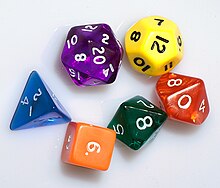
Various shapes such as two-sided or four-sided dice are documented in archaeological findings; for example, from Ancient Egypt and the Middle East. While the cubical six-sided die became the most common type in many parts of the world, other shapes were always known, like 20-sided dice in Ptolemaic and Roman times.
The modern tradition of usingsetsof polyhedral dice started around the end of the 1960s when non-cubical dice became popular among players ofwargames,[28]and since have been employed extensively inrole-playing gamesandtrading card games.Dice using both the numerals 6 and 9, which are reciprocally symmetric through rotation, typically distinguish them with a dot or underline.
Common variations[edit]
Dice are often sold in sets, matching in color, of six different shapes. Five of the dice are shaped like thePlatonic solids,whose faces areregular polygons.Aside from the cube, the other four Platonic solids have 4, 8, 12, and 20 faces, allowing for those number ranges to be generated. The only other common non-cubical die is the 10-sided die, apentagonal trapezohedrondie, whose faces are tenkites,each with two different edge lengths, three different angles, and two different kinds of vertices. Such sets frequently include a second 10-sided die either of contrasting color or numbered by tens, allowing the pair of 10-sided dice to be combined to generate numbers between 1 and 100.
Using these dice in various ways, games can closely approximate a variety ofprobability distributions.For instance, 10-sided dice can be rolled in pairs to produce auniform distributionof random percentages, and summing the values of multiple dice will produce approximations tonormal distributions.[29]
Unlike other common dice, afour-sided (tetrahedral) diedoes not have a side that faces upward when it is at rest on a surface, so it must be read in a different way. On some four-sided dice, each face features multiple numbers, with the same number printed near each vertex on all sides. In this case, the number around the vertex pointing up is used. Alternatively, the numbers on a tetrahedral die can be placed at the middle of the edges, in which case the numbers around the base are used.
Normally, the faces on a die will be placed so opposite faces will add up to one more than the number of faces. (This is not possible with 4-sided dice and dice with an odd number of faces.) Some dice, such as those with 10 sides, are usually numbered sequentially beginning with 0, in which case the opposite faces will add to one less than the number of faces.
Some twenty-sided dice have a different arrangement used for the purpose of keeping track of an integer that counts down, such as health points. Thesespindown diceare arranged such that adjacent integers appear on adjacent faces, allowing the user to easily find the next lower number. They are commonly used withcollectible card games.[30]
| Faces/sides | Shape | Notes | |
|---|---|---|---|
| 4 | Tetrahedron | Each face has three numbers, arranged such that the upright number, placed either near the vertex or near the opposite edge, is the same on all three visible faces. The upright numbers represent the value of the roll. This die does not roll well and thus it is usually thrown into the air instead. | |
| 6 | Cube | A common die. The sum of the numbers on opposite faces is 7. | |
| 8 | Octahedron | Each face is triangular and the die resembles twosquare pyramidsattached base-to-base. Usually, the sum of the opposite faces is 9. | |
| 10 | Pentagonal trapezohedron | Each face is akite.The die has two sharp corners, where five kites meet, and ten blunter corners, where three kites meet. The ten faces usually bear numbers from zero to nine rather than one to ten (zero being read as "ten" in many applications). Often, allodd numberedfaces converge at one sharp corner, and theevenones at the other. The sum of the numbers on opposite faces is usually 9 (if numbered 0–9) or 11 (if numbered 1–10). | |
| 12 | Dodecahedron | Each face is a regular pentagon. The sum of the numbers on opposite faces is usually 13. | |
| 20 | Icosahedron | Faces areequilateral triangles.Icosahedra have been found dating to Roman/Ptolemaic times, but it is not known if they were used as gaming dice. Modern dice with 20 sides are sometimes numbered 0–9 twice as an alternative to 10-sided dice. The sum of the numbers on opposite faces is 21 if numbered 1–20. | |
Rarer variations[edit]

"Uniform fair dice" are dice where all faces have an equal probability of outcome due to the symmetry of the die as it isface-transitive.In addition to the Platonic solids, these theoretically include:
- Catalan solids,thedualsof the 13Archimedean solids:12, 24, 30, 48, 60, 120 sides
- Trapezohedra,the duals of the infinite set ofantiprisms,with kite faces: any even number not divisible by 4 (so that a face will face up), starting from 6
- Bipyramids,the duals of the infinite set ofprisms,with triangle faces: any multiple of 4 (so that a face will face up), starting from 8
- Disphenoids,an infinite set of tetrahedra made from congruent non-regular triangles: 4 sides. This is a less symmetric tetrahedron than the Platonic tetrahedron but still sufficiently symmetrical to be face-transitive. Similarly,pyritohedraandtetartoidsare less symmetrical but still face-transitive dodecahedra: 12 sides.
Two other types of polyhedra are technically not face-transitive but are still fair dice due to symmetry:
- antiprisms:the basis ofbarrel dice
- prisms:the basis of long dice and teetotums
Long diceandteetotumscan, in principle, be made with any number of faces, including odd numbers.[31]Long dice are based on the infinite set ofprisms.All the rectangular faces are mutually face-transitive, so they are equally probable. The two ends of the prism may be rounded or capped with a pyramid, designed so that the die cannot rest on those faces. 4-sided long dice are easier to roll than tetrahedra and are used in the traditional board gamesdayakattaianddaldøs.
| Faces/sides | Shape | Image | Notes |
|---|---|---|---|
| 1 | Möbius striporsphere | Most commonly ajokedie, this is either a sphere with a 1 marked on it or shaped like aMöbius strip.It entirely defies the aforementioned use of a die. | |
| 2 | FlatCylinderor FlatPrism | Acoin flip.Some coins with 1 marked on one side and 2 on the other are available, but most simply use a common coin. | |
| 3 | Rounded-offtriangular prism | A long die intended to be rolled lengthwise. When the die is rolled, one edge (rather than a side) appears facing upwards. On either side of each edge the same number is printed (from 1 to 3). The numbers on either side of the up-facing edge are read as the result of the die roll. | |
| 4 | Capped 4-sidedlong die | A long die intended to be rolled lengthwise. It cannot stand on end as the ends are capped. | |
| 5 | |||
| Triangular prism | A prism that is thin enough to land either on its "edge" or "face". When landing on an edge, the result is displayed by digits (2–4) close to the prism's top edge. The triangular faces are labeled with the digits 1 and 5. Note that this design is not isohedral. | ||
| Capped 5-sidedlong die | Five-faced long die for the Korean Game of Dignitaries; notches indicating values are cut into the edges, since in an odd-faced long die these land uppermost. | ||
| 6 | Capped 6-sidedlong die | Two six-faced long dice are used to simulate the activity of scoring runs and taking wickets in the game ofcricket.Originally played with labeled six-sided pencils, and often referred to aspencil cricket. | |
| 7 | Pentagonal prism | Similar in constitution to the 5-sided die. Seven-sided dice are used in aseven-player variantofbackgammon.Seven-sided dice are described in the 13th centuryLibro de los juegosas having been invented byAlfonso Xin order to speed up play inchess variants.[32][33]Note that this design is not isohedral. | |
| Truncated sphere | A truncated sphere with seven landing positions. Note that this design is not isohedral. | ||
| 9 | Truncated sphere | A truncated sphere with nine landing positions. Note that this design is not isohedral. | |
| 10 | Decahedron | A ten-sided die made by truncating two opposite vertices of an octahedron. Note that this design is not isohedral. | |
| 11 | Truncated sphere | A truncated sphere with eleven landing positions. Note that this design is not isohedral. | |
| 12 | Rhombic dodecahedron | Each face is arhombus. | |
| 13 | Truncated sphere | A truncated sphere with thirteen landing positions. Note that this design is not isohedral. | |
| 14 | Heptagonal trapezohedron | Each face is akite. | |
| Truncated octahedron | A truncated octahedron. Each face is either a square or a hexagon. Note that this design is not isohedral. | ||
| Truncated sphere | A truncated sphere with fourteen landing positions. The design is based on thecuboctahedron.Note that this design is not isohedral. | ||
| 15 | Truncated sphere | A truncated sphere with fifteen landing positions. Note that this design is not isohedral. | |
| 16 | Octagonal bipyramid | Each face is an isosceles triangle. | |
| 17 | Truncated sphere | A truncated sphere with seventeen landing positions. Note that this design is not isohedral. | |
| 18 | Roundedrhombicuboctahedron | Eighteen faces are squares. The eight triangular faces are rounded and cannot be landed on. Note that this design is not isohedral. | |
| 19 | Truncated sphere | A truncated sphere with nineteen landing positions. Note that this design is not isohedral. | |
| 21 | Truncated sphere | A truncated sphere with twenty-one landing positions. Note that this design is not isohedral. | |
| 22 | Truncated sphere | A truncated sphere with twenty-two landing positions. Note that this design is not isohedral. | |
| 24 | Triakis octahedron | Each face is an isosceles triangle. | |
| Tetrakis hexahedron | Each face is an isosceles triangle. | ||
| Deltoidal icositetrahedron | Each face is a kite. | ||
| Pseudo-deltoidal icositetrahedron | Each face is a kite. | ||
| Pentagonal icositetrahedron | Each face is an irregular pentagon. | ||
| 26 | Truncated sphere | A truncated sphere with twenty-six landing positions. Note that this design is not isohedral. | |
| 28 | Truncated sphere | A truncated sphere with twenty-eight landing positions. Note that this design is not isohedral. | |
| 30 | Rhombic triacontahedron | Each face is a rhombus. | |
| 32 | Truncated sphere | A truncated sphere with thirty-two landing positions. The design is similar to that of atruncated icosahedron.Note that this design is not isohedral. | |
| 34 | Heptadecagonaltrapezohedron | Each face is a kite. | |
| 36 | Truncated sphere | A truncated sphere with thirty-six landing positions. Rows of spots are present above and below each number 1 through 36 so that this die can be used to roll two six-sided dice simultaneously. Note that this design is not isohedral. | |
| 48 | Disdyakis dodecahedron | Each face is ascalene triangle. | |
| 50 | Icosipentagonal trapezohedron | Each face is a kite. | |
| 60 | Deltoidal hexecontahedron | Each face is a kite. | |
| Pentakis dodecahedron | Each face is an isosceles triangle. | ||
| Pentagonal hexecontahedron | Each face is an irregular pentagon. | ||
| Triakis icosahedron | Each face is an isosceles triangle. | ||
| 100 | Zocchihedron | A sphere containing another sphere with 100 facets flattened into it. Note that this design is not isohedral; it does not function as a uniform fair die as some results are more likely than others. | |
| 120 | Disdyakis triacontahedron | Each face is a scalene triangle. |
Non-numeric dice[edit]

The faces of most dice are labelled using sequences of whole numbers, usually starting at one, expressed with either pips or digits. However, there are some applications that require results other than numbers. Examples include letters forBoggle,directions forWarhammer Fantasy Battle,Fudge dice,playing card symbols forpoker dice,and instructions for sexual acts usingsex dice.
Alternatively-numbered dice[edit]
Dice may have numbers that do not form a counting sequence starting at one. One variation on the standard die is known as the "average" die.[34][35]These are six-sided dice with sides numbered2, 3, 3, 4, 4, 5,which have the samearithmetic meanas a standard die (3.5 for a single die, 7 for a pair of dice), but have a narrower range of possible values (2 through 5 for one, 4 through 10 for a pair). They are used in some table-topwargames,where a narrower range of numbers is required.[35]Other numbered variations includeSicherman diceandintransitive dice.
Spherical dice[edit]
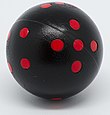
A die can be constructed in the shape of a sphere, with the addition of an internal cavity in the shape of thedual polyhedronof the desired die shape and an internal weight. The weight will settle in one of the points of the internal cavity, causing it to settle with one of the numbers uppermost. For instance, a sphere with an octahedral cavity and a small internal weight will settle with one of the 6 points of the cavity held downwards by the weight.
Applications[edit]

Many board games use dice to randomize how far pieces move or to settle conflicts. Typically, this has meant that rolling higher numbers is better. Some games, such asAxis & Allies,have inverted this system by making the lower values more potent. In the modern age,[when?]a few games and game designers have approached dice in a different way by making each side of the die similarly valuable. InCastles of Burgundy,players spend their dice to take actions based on the die's value. In this game, a six is not better than a one, or vice versa. InQuarriors(and its descendant,Dicemasters), different sides of the dice can offer completely different abilities. Several sides often give resources while others grant the player useful actions.[36]
Dice can be used fordivinationand using dice for such a purpose is calledcleromancy.A pair of common dice is usual, though other forms of polyhedra can be used. Tibetan Buddhists sometimes use thismethod of divination.It is highly likely that thePythagoreansused thePlatonic solidsas dice. They referred to such dice as "the dice of the gods" and they sought to understand the universe through an understanding of geometry in polyhedra.[37]
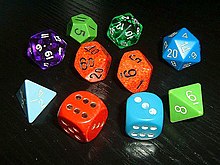
Polyhedral dice are commonly used in role-playing games. The fantasy role-playing gameDungeons & Dragons(D&D) is largely credited with popularizing dice in such games. Some games use only one type, likeExaltedwhich uses only ten-sided dice. Others use numerous types for different game purposes, such as D&D, which makes use of all common polyhedral dice. Dice are usually used to determine the outcome of events. Games typically determine results either as a total on one or more dice above or below a fixed number, or a certain number of rolls above a certain number on one or more dice. Due to circumstances or character skill, the initial roll may have a number added to or subtracted from the final result, or have the player roll extra or fewer dice. To keep track of rolls easily,dice notationis frequently used.
Astrological dice are a specialized set of three 12-sided dice for divination; the first die represents the planets, the Sun, the Moon, and thenodesof the Moon, the second die represents the 12zodiac signs,and the third represents the12 houses.A specialized icosahedron die provides the answers of theMagic 8 Ball,conventionally used to provide answers to yes-or-no questions.
Dice can be used to generate random numbers for use inpasswordsandcryptographyapplications. TheElectronic Frontier Foundationdescribes a method by which dice can be used to generatepassphrases.[38]Dicewareis a method recommended for generating secure but memorable passphrases, by repeatedly rolling five dice and picking the corresponding word from a pre-generated list.[39]
Notation[edit]
In many gaming contexts, especially tabletop role-playing games, shorthand notations representing different dice rolls are used. A "d" or "D" is used to indicate a die with a specific number of sides; for example,d4denotes a four-sided die. If several dice of the same type are to be rolled, this is indicated by a leading number specifying the number of dice. Hence,6d8means the player should roll six eight-sided dice and add the results. Modifiers to a die roll can also be indicated as desired. For example,3d6+4instructs the player to roll three six-sided dice, calculate the total, and add four to it.
See also[edit]
- Astragalomancy– Form of divination
- Crown and Anchor– Dice game
- d20 System– Role-playing game system
- Dreidel– Four-sided spinning top used on Hanukkah
- Fuzzy dice– Automobile decoration
- Musikalisches Würfelspiel– Musical dice games used to randomly generate music
- Die throw (review)– Method of review often used in Norway
- Intransitive dice– Game variations and descriptions of intransitive die and their behaviour
- Quincunx– Pattern of five points, four in a square or rectangle and a fifth at its center
- Teetotum– Spinning lot, generating random outcomes
- Urim and Thummim– Objects used for divination in the early Abrahamic religions
References[edit]
- ^"die, n.1".OED Online.Oxford University Press.Retrieved1 December2023.
- ^Laird, Jay (2009).Encyclopedia of Play in Today's Society.SAGE Publications. pp. 171–173.ISBN978-1-4522-6610-7.
- ^Finkel, Irving (2008)."Board Games".Beyond Babylon: Art, Trade, and Diplomacy in the Second Millennium B.C.Metropolitan Museum of Art. p. 151.ISBN978-1-58839-295-4.
- ^"8 Oldest Board Games in the World".Oldest.org.29 November 2017.Retrieved12 March2022.
- ^NASER MOGHADASI, Abdorreza (September 2015)."The Burnt City and the Evolution of the Concept of" Probability "In the Human Brain".Iranian Journal of Public Health.44(9): 1306–1307.ISSN2251-6085.PMC4645795.PMID26587512.
- ^"National Museums of Scotland - Two bone dice".nms.scran.ac.uk.Retrieved9 May2020.
- ^Possehl, Gregory. "Meluhha". In: J. Reade (ed.)The Indian Ocean in Antiquity.London: Kegan Paul Intl. 1996a, 133–208
- ^Ashmolean Museum, University of Oxford."Terracotta Dice".jameelcentre.ashmolean.org.Retrieved19 March2023.
- ^2.3, 4.38, 6.118, 7.52, 7.109
- ^Good, Alexandra."Knucklebones".Johns Hopkins Archaeological Museum.Retrieved16 April2015.
- ^Matz, David (2002).Daily Life of the Ancient Romans.Greenwood Publishing Group. pp.94–95.ISBN978-0-313-30326-5.
- ^"christies.com".christies.com.Retrieved18 June2012.
- ^ab"Twenty-sided die (icosahedron) with faces inscribed with Greek letters".metmuseum.org.Retrieved28 March2015.
- ^"domino | game piece | Britannica".www.britannica.com.Retrieved20 November2022.
- ^Ronan, Colin; Needham, Joseph (1986).The Shorter Science and Civilisation in China.Cambridge University Press. p. 55.ISBN978-0-521-31560-9.
- ^Salter, Rebecca (2006). "Board Games".Japanese Popular Prints: From Votive Slips to Playing Cards.University of Hawaii Press. p. 164.ISBN978-0-8248-3083-0.
- ^The Greek anthology.Translated by Paton, W.R. New York: G.P. Putnam's and Sons. 1918.
- ^ab"Standard Dice".Archived fromthe originalon 30 July 2013.
- ^"Chinese Dice".Elliott Avedon Museum & Archive of Games. Archived fromthe originalon 1 May 2008.
- ^"7 Surprising Facts About How Dice Are Made (With Pictures)".gmdice.com.19 August 2019.Retrieved20 August2019.
- ^"Casino Dice".www.dice-play.com.Retrieved1 July2018.
- ^"die".Oxford Dictionaries. Archived fromthe originalon 14 February 2015.Retrieved14 February2015.
- ^"ace".AskOxford. Archived fromthe originalon 29 September 2007.Retrieved18 June2012.
- ^Conant, Levi Leonard (1896).The Number Concept: Its Origin and Development.Macmillan. p. 124.
- ^"s | Search Online Etymology Dictionary".www.etymonline.com.
- ^"Dice faces in block Miscellaneous Symbols"(PDF).The Unicode standard.Archived(PDF)from the original on 3 June 2001.
- ^Horridge, Kevin (27 November 2017)."6 Ways Casinos Stop Dice Cheats".Casino.org.Retrieved11 October2019.
- ^Peterson, Jon (July 2012).Playing at the World: A History of Simulating Wars, People and Fantastic Adventures, from Chess to Role-Playing Games.Unreason Press. pp. 315–318.ISBN978-0-615-64204-8.
- ^Paret, Michelle; Martz, Eston (2009)."Tumbling Dice & Birthdays: Understanding the Central Limit Theorem"(PDF).Minitab. Archived fromthe original(PDF)on 1 November 2013.Retrieved29 September2013.
- ^Girdwood, Andrew (30 March 2019)."What's a spindown dice and are standard d20s any fairer?".Retrieved9 July2020.
- ^Kybos, Alea."Properties of Dice"(PDF).Archived fromthe original(PDF)on 28 May 2012.Retrieved7 October2012.
- ^"games.rengeekcentral.com".games.rengeekcentral.com.Retrieved18 June2012.
- ^"wwmat.mat.fc.ul.pt"(PDF).Archived(PDF)from the original on 2 March 2011.Retrieved18 June2012.
- ^"Specialist D6".em4miniatures.Retrieved18 August2017.
- ^ab"[TMP] 'What are Average Dice' Topic".The Miniatures Page.20 November 2009.Retrieved18 August2017.
- ^"Making better use of dice in games".2 October 2014.
- ^Guthrie, Kenneth (1988).The Pythagorean sourcebook and library: an anthology of ancient writings which relate to Pythagoras and Pythagorean philosophy.Grand Rapids, MI: Phanes Press.ISBN978-0-933999-50-3.OCLC255212063.
- ^"EFF Dice-Generated Passphrases".Electronic Frontier Foundation.12 May 2016.Retrieved16 November2018.
- ^"EFF's New Wordlists for Random Passphrases".Electronic Frontier Foundation.19 July 2016.Retrieved4 December2016.
Bibliography[edit]
- Diaconis, Persi;and Keller, Joseph B.;"Fair Dice",Archived21 February 2008 at theWayback Machine,The American Mathematical Monthly,96(4):337–339, 1989 (Discussion of dice that are fair "by symmetry" and "by continuity".)
- Iverson, G. R.; Longcour, W. H.; et al.;Bias and Runs in Dice Throwing and Recording: A Few Million Throws,Psychometrika, vol. 36, no. 1, March 1971
- Knizia, Reiner,Dice Games Properly Explained,Elliot Right Way Books, 1999,ISBN0-7160-2112-9
External links[edit]
- Weisstein, Eric W."Dice".MathWorld.– analysis of dice probabilities, also featuring Uspenski's work on rolling multiple dice
This article incorporates text from a publication now in thepublic domain:Chisholm, Hugh,ed. (1911). "Dice".Encyclopædia Britannica.Vol. 8 (11th ed.). Cambridge University Press. p. 176–177.

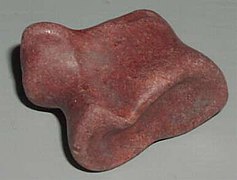
![Twenty-sided serpentinite die from Ptolemaic Egypt[13]](https://upload.wikimedia.org/wikipedia/commons/thumb/9/9b/Twenty-sided_die_%28icosahedron%29_with_faces_inscribed_with_Greek_letters_MET_10.130.1158_001.jpg/168px-Twenty-sided_die_%28icosahedron%29_with_faces_inscribed_with_Greek_letters_MET_10.130.1158_001.jpg)
